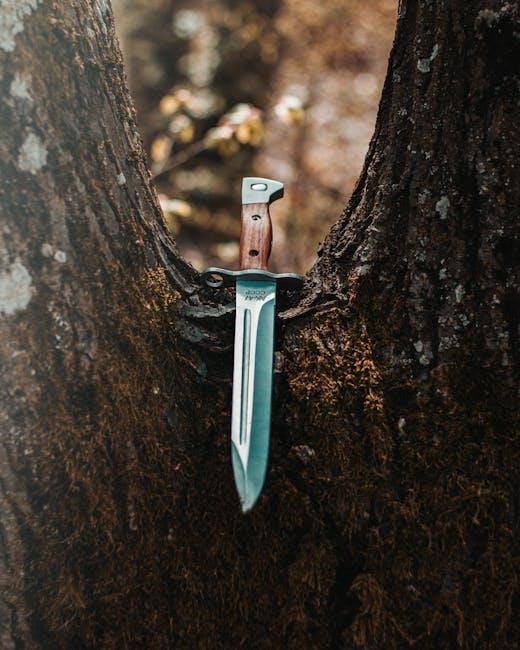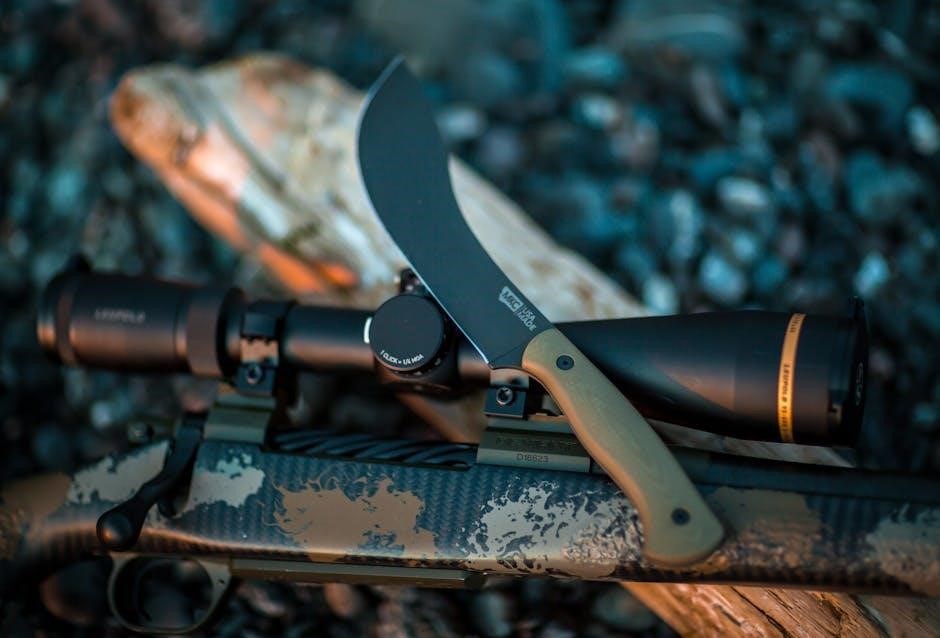Blade HQ is a trusted name in the knife community, offering a vast selection of knives and accessories. Their Steel Guide is a detailed resource designed to educate consumers on various steel types, their properties, and applications. It covers edge retention, corrosion resistance, and toughness, helping users make informed decisions. The guide is tailored for both newcomers and enthusiasts, providing clear insights into steel performance. By breaking down complex metallurgy, Blade HQ empowers buyers to choose the best steel for their needs, ensuring durability and satisfaction in their knife purchases.
1.1 Overview of Blade HQ and Their Steel Guide
Blade HQ is a trusted name in the knife community, offering a wide range of knives and accessories. Their Steel Guide is a comprehensive resource designed to educate consumers on knife steel, covering key properties like edge retention, corrosion resistance, and toughness. The guide provides detailed insights into various steel types, their compositions, and applications, making it an essential tool for both newcomers and enthusiasts. Blade HQ collaborates with experts like Larrin Thomas of Knife Steel Nerds to ensure accuracy and depth. This guide simplifies the complexities of metallurgy, helping users make informed decisions when selecting the best steel for their needs.
1.2 Why Steel Quality Matters in Knives
Steel quality is crucial as it determines a knife’s performance, longevity, and reliability. High-quality steel ensures better edge retention, corrosion resistance, and durability, making it essential for both everyday carry and extreme use. A knife with superior steel holds its sharpness longer, resists environmental factors like moisture, and requires less frequent sharpening. This enhances user satisfaction and reduces maintenance. Blade HQ emphasizes that investing in high-quality steel offers long-term value, ensuring the knife remains functional and reliable across various tasks and environments. Steel quality directly impacts a knife’s functionality, making it a critical factor in knife selection.
Key Properties of Knife Steel
Blade HQ’s Steel Guide highlights key properties like edge retention, toughness, and corrosion resistance, essential for understanding knife performance and selecting the right steel for specific tasks.
2.1 Edge Retention: How Well a Blade Holds Its Sharpness
Edge retention is a critical factor in knife performance, determining how well a blade maintains its sharpness over time. According to Blade HQ’s Steel Guide, high-quality steels like S30V and S35VN excel in retaining their edge even after heavy use. Edge retention is influenced by the steel’s hardness and microstructure, with harder steels generally holding their edge longer. Proper heat treatment is essential to maximize edge retention, as it enhances the steel’s ability to resist wear and deformation. A blade with superior edge retention requires less frequent sharpening, making it ideal for demanding tasks such as cutting through tough materials or processing large amounts of cardboard. Blade HQ emphasizes that edge retention is a key indicator of a steel’s overall performance and durability in real-world applications.
2.2 Toughness: The Blade’s Ability to Withstand Impact
Toughness refers to a knife’s ability to withstand impact and resist breaking or chipping under stress. According to Blade HQ’s Steel Guide, steels with high toughness, such as D2 or 5160, are ideal for hard-use applications like chopping or batoning. These steels can absorb heavy abuse without failing, making them suitable for rugged tasks. While excessive toughness may sometimes compromise edge retention, proper heat treatment and steel composition help achieve a balance between strength and sharpness. Blade HQ highlights that toughness is crucial for knives subjected to extreme conditions, ensuring reliability and durability in demanding situations.
2.3 Corrosion Resistance: Steel’s Ability to Resist Rust and Damage
Corrosion resistance is a critical factor in knife steel, especially for knives exposed to moisture or humid environments. Blade HQ’s Steel Guide emphasizes that steels with high chromium content, such as 420HC or S30V, exhibit superior corrosion resistance compared to carbon steels. Proper maintenance, like regular cleaning and drying, can further enhance a knife’s longevity. Applying a rust-inhibiting oil or coating also helps protect the blade. While high-carbon steels may require more care, their exceptional sharpness and edge retention make them a worthwhile choice for users willing to maintain them. Balancing corrosion resistance with other properties ensures optimal performance for specific tasks and environments.

Types of Steel Used in Knives
Knife steels include carbon, alloy, tool, and stainless types, each offering unique performance traits like sharpness, durability, and corrosion resistance for specific knife applications.
3.1 Carbon Steels: High Performance and Sharpness
Carbon steels, known for their high carbon content, deliver exceptional sharpness and edge retention, making them ideal for high-performance knives. They are prized for their hardness, durability, and ease of sharpening, often used in hard-use applications. While they lack corrosion resistance compared to stainless steels, their superior cutting efficiency makes them a favorite among knife enthusiasts. Proper maintenance is essential to prevent rust, but their reliability in demanding tasks justifies the extra care. Blade HQ highlights their popularity in premium knives, balancing strength and sharpness for reliable field-proven tools.
3.2 Alloy Steels: Enhanced Durability and Versatility
Alloy steels, enhanced with elements like chromium, vanadium, and molybdenum, offer improved durability and versatility compared to carbon steels. They provide better corrosion resistance, toughness, and wear resistance, making them ideal for high-performance knives. Steels like D2 and M390 are known for their excellent edge retention and durability, balancing hardness and strength. While they can be more challenging to sharpen, their superior properties make them a popular choice for both everyday carry and hard-use applications. Alloy steels are versatile, adapting well to various tasks, and are favored for their reliability and longevity in demanding conditions.
3.3 Tool Steels: Exceptional Hardness and Wear Resistance
Tool steels, such as D2 and A2, are renowned for their exceptional hardness and durability, making them ideal for high-wear applications. These steels contain high carbon content and alloying elements like chromium and vanadium, which enhance their resistance to deformation and wear. They are often used in hard-use knives due to their ability to withstand heavy tasks without losing shape. While they can be more challenging to sharpen, their longevity and strength make them a favorite among professionals. Tool steels are a robust choice for users prioritizing durability over ease of maintenance, ensuring reliability in extreme conditions.
3.4 Stainless Steels: Balancing Sharpness and Corrosion Resistance
Stainless steels, such as 420HC and 154CM, excel in corrosion resistance, making them perfect for marine or wet environments. These steels contain chromium, which forms a protective layer against rust. While they may sacrifice some edge retention compared to carbon steels, their durability and low maintenance make them ideal for everyday use. Stainless steels offer a balance between strength and corrosion resistance, providing a practical choice for users seeking reliability without the need for constant care. Their versatility ensures long-lasting performance in various conditions, making them a popular option for both utility and outdoor applications.

Factors Influencing Steel Performance
Material composition, heat treatment, and alloying elements significantly impact steel performance, affecting edge retention, corrosion resistance, and toughness. These factors determine a knife’s durability and reliability in various applications.
4.1 Material Composition and Its Impact on Steel Properties
Material composition is the foundation of steel performance, with elements like carbon, chromium, and vanadium influencing edge retention, corrosion resistance, and toughness. Higher carbon content enhances hardness and sharpness, while chromium boosts corrosion resistance. Alloying elements such as molybdenum and nickel improve strength and durability. The balance of these elements determines the steel’s suitability for specific applications, whether for everyday carry or heavy-duty use. Blade HQ’s guide highlights how these compositional variations impact real-world performance, helping users understand the science behind steel selection and optimization for their needs.
4.2 Heat Treatment: Maximizing Steel Potential
Heat treatment is a critical process that enhances steel properties, ensuring optimal performance. Techniques like quenching and tempering adjust hardness, toughness, and corrosion resistance. Proper heat treatment maximizes edge retention, durability, and sharpness, tailoring the steel for specific applications. Blade HQ’s guide emphasizes that heat-treated steels, such as S30V and M390, achieve superior edge retention and wear resistance. This process is essential for unlocking a steel’s full potential, making it suitable for demanding tasks. By refining the microstructure, heat treatment ensures knives deliver consistent and reliable performance in various environments and uses.

Popular Steel Types and Their Characteristics
Blade HQ’s guide categorizes steels into high-end, mid-range, and budget options, highlighting their unique properties for edge retention, corrosion resistance, and toughness, aiding enthusiasts in selecting the best steel for their needs.
5.1 High-End Steels: S30V, S35VN, and M390
High-end steels like S30V, S35VN, and M390 are renowned for their exceptional edge retention, corrosion resistance, and wear resistance. S30V, a popular choice for premium knives, offers outstanding sharpness and durability. S35VN, an upgraded version of S30V, enhances toughness while maintaining superior edge retention. M390, known for its high chromium content, excels in corrosion resistance and is ideal for harsh environments. These steels are often used in high-end knives due to their balanced properties, making them suitable for demanding applications. Blade HQ’s guide highlights their premium performance, catering to enthusiasts seeking top-tier knife steel.
5.2 Mid-Range Steels: 154CM, 14C28N, and 420HC
Mid-range steels like 154CM, 14C28N, and 420HC offer a balance of performance and affordability. 154CM is known for its excellent edge retention and corrosion resistance, making it a versatile choice for everyday carry. 14C28N provides a balance of sharpness and durability, while 420HC excels in corrosion resistance and ease of sharpening. These steels are popular for their reliability and adaptability, catering to both enthusiasts and practical users. Blade HQ’s guide highlights their accessibility and performance, making them ideal for those seeking quality without the premium price tag.
5.3 Budget-Friendly Steels: 420J1, 420J2, and 8Cr13MoV
Budget-friendly steels like 420J1, 420J2, and 8Cr13MoV offer reliable performance at an affordable price. These steels are known for their corrosion resistance, ease of sharpening, and durability, making them ideal for everyday carry knives. 420J1 and 420J2 are commonly used in entry-level knives, providing decent edge retention and resistance to rust. 8Cr13MoV, while slightly higher in performance, remains budget-friendly and is often found in Chinese-made knives. These steels are perfect for those seeking a balance of affordability and functionality without compromising on essential qualities, ensuring great value for casual users and first-time buyers.

Steel Comparisons and Recommendations
Blade HQ provides detailed steel comparisons and recommendations, helping users choose the best steel for their needs. Their guide simplifies the process of selecting the ideal steel for specific tasks.
6.1 Comparing Edge Retention Across Different Steels
Edge retention is a critical factor in knife performance, determined by a steel’s hardness and microstructure. Blade HQ’s guide compares various steels, with high-end options like S30V and S35VN excelling in retaining sharpness. These steels, often used in premium knives, hold their edges longer, reducing the need for frequent sharpening. The guide emphasizes that proper heat treatment maximizes edge retention, making these steels ideal for demanding tasks. By understanding edge retention, users can select blades that meet their specific needs for durability and performance, ensuring reliable use in various applications.
6.2 Choosing the Right Steel for Your Knife Needs
Choosing the right steel for your knife involves balancing edge retention, corrosion resistance, and toughness based on its intended use. Blade HQ’s guide recommends high-carbon steels like 1095 for durability in outdoor tasks, while stainless steels such as 420HC are ideal for marine environments. For everyday carry, mid-range steels like 14C28N offer a versatile balance of sharpness and durability. The guide also highlights tool steels like D2 for extreme wear resistance. By considering these factors and applications, users can select a steel that optimizes their knife’s performance, ensuring reliability and longevity in various conditions and tasks.
Blade HQ’s Steel Guide is a trusted resource for knife enthusiasts, offering comprehensive insights into steel types and their properties. It empowers users to make informed decisions, ensuring optimal knife performance and durability for various needs.
7.1 Final Thoughts on Blade HQ’s Steel Guide
Blade HQ’s Steel Guide is an indispensable tool for knife enthusiasts, providing a thorough understanding of steel types and their properties. By simplifying complex metallurgy, it helps users select the best steel for their needs, ensuring durability and satisfaction. Whether for everyday carry or extreme use, the guide’s insights on edge retention, corrosion resistance, and toughness are invaluable. This resource not only educates but also empowers, making it a go-to for anyone seeking a reliable knife tailored to their lifestyle and preferences.